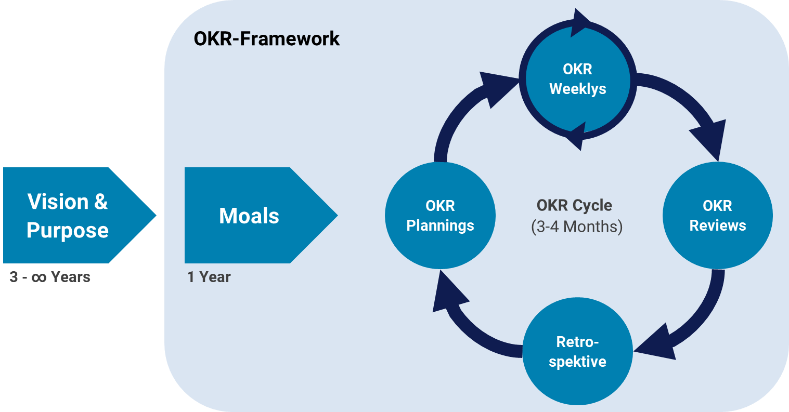Challenges of agile strategy implementation and goal-oriented employee management
Currently, many companies have converted their organizational structure and processes in parts or comprehensively to an agile model in order to achieve more flexibility and a value-maximizing focus of budgets and resources. Our experience is that from a certain scope of scaled agility onwards, an overarching, coordinated agile target management system must also be established - we advise on this on the basis of the OKR framework (Objectives and Key Results).
Particularly when larger, scaled agile organizational units have established their delivery organization, challenges increasingly arise in planning and managing corporate goals for strategy implementation.
Central to this is that teams or departments are often decoupled from the overarching corporate strategy or it is not clearly formulated at all. Employees at all levels of the hierarchy thus often find it difficult to transparently recognize the value contribution of their work to the overarching goals. We often see managers setting goals top-down without gaining sufficient insight into the actual challenges of the team's day-to-day work, and consequently communicating uncoordinated or unrealistic goals and expectations. In most cases, goals are broken down directly to individuals and measured against fixed KPIs.
Consequently, we see in many companies that employees optimize themselves in the form of meeting their personal KPIs as easily as possible. The focus is then on achieving personal goals (measured by output) instead of focusing on a value-creating outcome to achieve the corporate strategy.
Benefits and reasons for the OKR method in the agile environment
To address the above challenges, the framework is gaining more and more acceptance.
OKR focus on the overarching alignment of agile organizations to the values and goals of the business. A successful agile enterprise is also founded on the interaction of the three elements of vision/strategy, agile delivery organization and agile goal management for strategy implementation - considered here in the framework OKR. The guiding principle here is: "Develop the right product (vision/strategy) right (agile delivery organization) for the right goals (agile goal management)".
In doing so, we perceive various positive effects in everyday project work when companies design their agile target management with OKR.
Alignment: In particular, the focus on the targeted implementation of the company's corporate strategy makes it tangible for every employee.
Adaptability: Due to an agile process based on agile cycles, goals can be regularly revised depending on the time horizon and adapted based on current market conditions.
Cross-functional alignment: Due to the cross-functional alignment, the collaboration of dependent departments and teams is strengthened to provide a real value contribution.
Productivity & measurability: The OKR framework enables a clear process for setting goals and demonstrating progress in product and service development.
Motivation & Engagement: We also note that our customers' employees show increased motivation due to co-creating their own team-based goals.
As a result, goals are usually more realistic, transparent and strategy implementation in an agile context becomes structured.
How does the OKR framework work?
OKR is a goal management framework for modern and agile organizations to implement corporate strategy.
In this context, OKR is a management tool that has a clear focus on the overall goal management of the company, not on the performance of individual employees. OKR is used especially for companies in a complex environment to react iteratively to (market) changes across all company levels. In the spirit of the agile mindset, OKR also claim decentralized decision-making on goal setting within various organizational units.

The adjacent diagram shows how OKR is to be understood as a link between the corporate vision and the agile operationalization of agile teams. Here, OKR basically defines an interplay between qualitative, long-term goals as ambition levels and concrete, measurable OKR sets.
The core of the OKR framework is the agile OKR ceremonies, which run in a clear cycle for an established goal management process. Midterm goals (Moals) fundamentally show the direction in which the company would like to evolve. Following this, an OKR cycle is running through in a fixed cycle of usually 3 months. An OKR cycle begins with an OKR planning for the alignment of the goals and operationalization with measurable 3-month goals. In line with the agile way of working, the operationalization of the goals is accompanied by weekly reviews, reviews of goal achievement and internal retrospectives.
The NTT DATA approach to integrate OKR into SAFe
As described at the beginning, companies often build OKR on top of already established agile delivery organization structures. Since we often already accompany our customers in the implementation of an agile delivery organization according to SAFe (Scaled Agile Framework for Enterprises), we have made it our task to actively link the frameworks OKR and SAFe on all levels.
Due to the practicality in everyday project work as well as the clear similarities, we have recognized the need and also the possibilities to combine both frameworks.

The above diagram illustrates our starting points due to the obvious similarities of both frameworks. While OKR focuses on operationalizing the strategy in an outcome-oriented 3-month cycle, SAFe pursues the purpose of setting up an agile organizational model for product/service development in a 3-month cycle as well. Both frameworks cascade in 4 steps across all hierarchy levels and end with the same element that unites both frameworks - the concrete tasks of the employees.
We often experience the case where entire organizational units are already working in agile cycles, but others are structured with classic project management methods and structures. Even in this particular context, OKR can integrate cross-cutting processes for alignment, as OKR ceremonies for agile goal setting run independently of the events of agile delivery organizations.
For this reason, we can also recommend our approach to integrating OKR and SAFe in terms of our NTT DATA Liquid Enterprise Initiative - that is, combining agile with classic structures.
NTT DATA's offering on OKR Consulting
We understand our OKR consulting primarily as an asset that can be applied flexibly. We do not recommend a pure implementation of the prevailing OKR theory, but with our OKR Consulting you receive a solution approach, which is adapted to the individual needs of your organization by experienced consultants.
Together with your executives we define the way of your individual OKR implementation, so that OKR becomes an integral part of your basic agile structure and methodology.
To this end, we bring successfully established best practices from other projects and provide a comprehensive toolkit with recommended standards. This contains among others:
- OKR Readiness Assessment and derived recommended actions for OKR implementation.
- OKR coaching for management and executives
- OKR hands-on training for all end users and stakeholders (including NTT DATA certifications)
- Implementation roadmap
- Kick-Off and coaching of OKR ceremonies
- Support of the OKR transformation regarding change management in your company
- Concept for the overview of roles and responsibilities
- Integration of the OKR methodology into the existing agile organization model
This OKR toolkit provides you with a fixed and proven framework for the implementation. Through this framework, the implementation can be customized without disregarding the need for OKR-overarching standards.
Author: Sven Bauer, Senior Consultant Transformation Management, NTT DATA DACH



